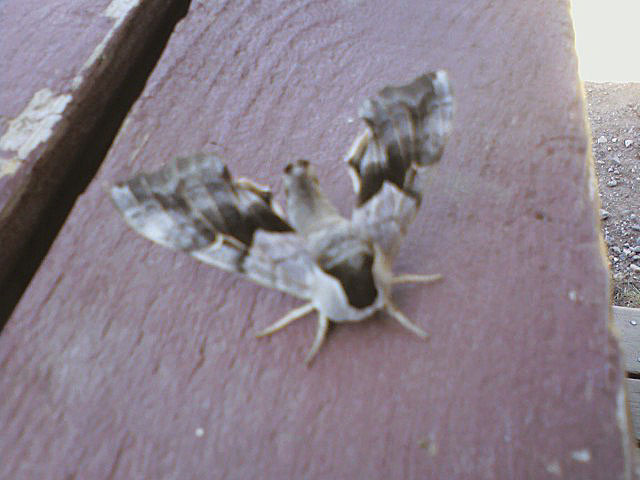Sphinginae subfamily
Sphingini tribe:
 |
This large bodied moth flies in tobacco fields and vegetable gardens (potatoes, tomatoes)
and wherever host plants are found. |
 |
If you grow tomatoes, you may have encountered it, but it has not been
officially reported in La Plata County.
Larvae get very large and can strip a tomato plant.
|
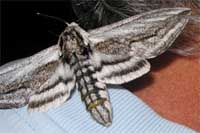 |
The upperside of the forewing has a wide white band along the costa
from base to apex. The remainder of the wing has black and white
bands.
|
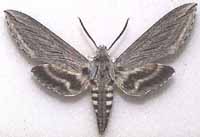 |
The upperside of the forewing is pale silver-gray with a series of
black dashes, a white patch at the tip, and a white stripe along the
outer margin. The upperside of the hindwing is black with blurry
white bands.
|
 |
Sphinx chersis
WO,
the Northern Ash Sphinx or Great Ash Sphinx
Larval hosts are ash,
lilac, privet, cherry, and quaking aspen.
|
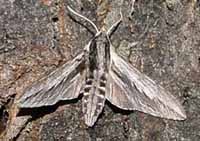 | Sphinx dollii (Wing span: 1 3/4 - 2 1/2 inches (4.5 - 6.3 cm)),
flies in arid brushlands and desert foothills from Nevada and
southern California east through Utah,
Arizona, Colorado, and New Mexico to Oklahoma and Texas. (possibly in eastern Inyo Co.)
|
 |
Forewings, long and slender, are held close to the body when the moth
is at rest. (northern if present)
I only see them occasionally on P.E.I. despite visiting lights
frequently. |
 |
The upperside of the forewing ranges from brown with black borders
through brownish gray with paler borders to pale gray with no borders.
Dashes, submarginal line, and cell spot are usually weak.
|
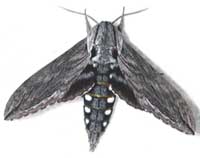 | The upperside of the forewing is pale blue-gray to dark gray with a black dash reaching the wing tip and
a white stripe along the lower outer margin.
The upperside of the hindwing is black with two diffuse white
bands, the upper one being practically non-existent.
|
 |
Sphinx luscitiosa
WO,
the Canadian Sphinx or
Clemen's Sphinx
This one is reported from Otsego, by USGS and also by Jonathan Tubbs.
|
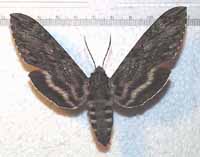 | The upperside of the forewing is dark gray with black and light gray
wavy lines. The upperside of the hindwing is black with a brownish
gray border and two white bands.
|
 |
Snowberry Sphinx adults fly as a single brood in montane woodlands and along prairie
streamcourses from April to August.
The upperside of the forewing has a narrow black subterminal line
bordered by a white inverted V-shaped line on the outside, and a
black line at the apex. |
Smerinthini Tribe:
 |
Pachysphinx modesta
WO,
the Modest Sphinx or Poplar Sphinx,
This moth has a large, heavy body, and females
can be remarkably plump.
|
 |
This one is quite similar to Pachysphinx modesta, with modesta
being smaller and darker.
Moths should be on the wing from June-August.
|
 |
The outer margin of the forewing is quite wavy. There
is a dark cell spot and a dark oblique line mid wing from the
costa almost to the inner margin. Basic ground colour is
pinkish brown. Flight would be June-July.
|
 | Named for the small eye-spot in the
hindwing, this moth has a wide
distribution.
|
 |
Smerinthus cerisyi
KM, the Cerisyi's
Sphinx or One-eyed Sphinx, Larvae feed on poplars and willows.
Flight would be from late May-July-early August as a single brood.
|
Smerinthus cerisyi, June 7-8, Karen McKibbin
 |
This moth is widely distributed and fairly common.
Along the East Coast, it flies from P.E.I. to Florida.
It is less common in the southwest. unlikely
|
Macroglossinae subfamily
Dilophonotini tribe:
 |
Hemaris diffinis
WO, the
Snowberry Clearwing or Bumblebee Moth
Hemaris diffinis is a very variable species, but almost always the
abdomen sports contrasting black and yellow hairs, the ventral
surface being quite black. The legs also tend to be quite dark and
there is a black mask running across the eye and along the sides of
the thorax.
|
 |
Hemaris senta,
WO, Rocky Mountain Clearwing Moth
These moths, possibly just a form of diffinis, have brownish-olive or olive-green heads and thoraxes.
The abdomen, which has a broad yellow band, is black or olive-green
above and yellow below. Their wings have a very narrow brown border
and the clear parts of the wings have a steel-blue luster.
|
Philampelini tribe:
 |
Adults nectar from flowers of Japanese honeysuckle
(Lonicera japonica), petunia (Petunia hybrida),
mock orange (Philadelphus coronarius), and phlox (Phlox).
Fight would be from June to August. Larvae feed on grape foliage.
|
Macroglossini tribe:
 |
Hyles lineata
USGS,
the White-lined Sphinx
Larvae can be quite varied.
|
 |
Darapsa myron
WO, the Virginia Creeper Sphinx or the
Grapevine Sphinx
This moth is not recorded on the U.S.G.S. site for Otsego County.
It is widely reported in southern Michigan and in southern Ontario.
If you have the foodplants indicated in the common names, you probably have this
species nearby. unlikely
|
 |
Euproserpinus wiesti
WO, Prairie Sphinx or Wiest's Primrose Sphinx:
Body is black with white band across abdomen. FW upperside
is gray-brown; median area has black lines and gray band;
underside is white with black outer margin.
Hw upperside is yellowish white with narrow black
outer margin, black at base; underside
is white with black at base and black marginal band.
|
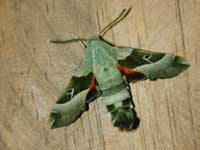 |
The upperside of the forewing is pale gray-green with a deep
green-brown median area and a white dash at the wing tip.
|
|
|
